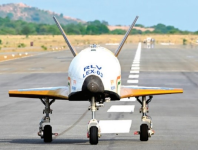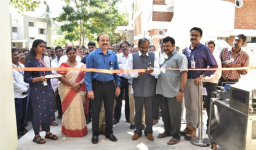ISRO Commissions Advanced Landing Gear Test Facility
April 04, 2025

A state-of-the-art Landing Gear Drop Test Facility is commissioned at Vikram Sarabhai Space Centre (VSSC), Thiruvananthapuram towards the testing and qualification of the deployable Landing Gear system for ISRO’s winged body Reusable Launch Vehicle – Pushpak. ISRO is developing Pushpak with a deployable Landing Gear towards the RLV-Orbital Re-entry Experiment (RLV-OREX), wherein the Pushpak vehicle will be launched to orbit in an ascent vehicle. Subsequently, after a few orbits, Pushpak will re-enter the atmosphere and land on a runway using the deployable Landing Gear system.

The Landing Gear Drop Test facility was inaugurated by Dr. V. Narayanan, Chairman, ISRO / Secretary, DOS at Vikram Sarabhai Space Centre on April 04, 2025 in the presence of Dr. Unnikrishnan Nair, Director, Vikram Sarabhai Space Centre (VSSC), Shri Rajarajan, Director, Satish Dhawan Space Centre (SDSC-SHAR) and Shri Padmakumar, Director, ISRO Inertial Systems Unit (IISU). The Landing Gear Drop facility has the capability to test various types of landing gears, such as telescopic, articulated and semi-articulated types and has several key features such as an adjustable drop mass up to 2000 kg to simulate various aircrafts and airport altitudes and adjustable drop height. The test rig is capable of simulating landing velocities up to 360 km/hr (100 m/s) with adjustable wheel spin speeds up to 5000 rpm. The test setup also allows simulation of various landing sink rates, up to 4.8 m/s. Different runway conditions such as asphalt, concrete, dry, wet and icy surfaces can also be simulated.
A comprehensive sensor suite is also part of the facility in order to measure the various parameters at the touch down point such as accelerometers to sense acceleration and velocity, high resolution displacement sensors such as LVDTs and LiDARs to sense the vertical motion and tri-axial load cells and strain gauges to sense landing forces, strain and moments experienced by the Landing Gear. This facility also integrates multiple safety features, such as a platform impact protector and a self-lock mechanism for the drop release actuator, ensuring protection for both personnel and test articles. This facility has the potential to accelerate the development and qualification of advanced RLVs and aircraft technologies in India.

ISRO Commissions Advanced Landing Gear Test Facility
April 04, 2025

A state-of-the-art Landing Gear Drop Test Facility is commissioned at Vikram Sarabhai Space Centre (VSSC), Thiruvananthapuram towards the testing and qualification of the deployable Landing Gear system for ISRO’s winged body Reusable Launch Vehicle – Pushpak. ISRO is developing Pushpak with a deployable Landing Gear towards the RLV-Orbital Re-entry Experiment (RLV-OREX), wherein the Pushpak vehicle will be launched to orbit in an ascent vehicle. Subsequently, after a few orbits, Pushpak will re-enter the atmosphere and land on a runway using the deployable Landing Gear system.

The Landing Gear Drop Test facility was inaugurated by Dr. V. Narayanan, Chairman, ISRO / Secretary, DOS at Vikram Sarabhai Space Centre on April 04, 2025 in the presence of Dr. Unnikrishnan Nair, Director, Vikram Sarabhai Space Centre (VSSC), Shri Rajarajan, Director, Satish Dhawan Space Centre (SDSC-SHAR) and Shri Padmakumar, Director, ISRO Inertial Systems Unit (IISU). The Landing Gear Drop facility has the capability to test various types of landing gears, such as telescopic, articulated and semi-articulated types and has several key features such as an adjustable drop mass up to 2000 kg to simulate various aircrafts and airport altitudes and adjustable drop height. The test rig is capable of simulating landing velocities up to 360 km/hr (100 m/s) with adjustable wheel spin speeds up to 5000 rpm. The test setup also allows simulation of various landing sink rates, up to 4.8 m/s. Different runway conditions such as asphalt, concrete, dry, wet and icy surfaces can also be simulated.
A comprehensive sensor suite is also part of the facility in order to measure the various parameters at the touch down point such as accelerometers to sense acceleration and velocity, high resolution displacement sensors such as LVDTs and LiDARs to sense the vertical motion and tri-axial load cells and strain gauges to sense landing forces, strain and moments experienced by the Landing Gear. This facility also integrates multiple safety features, such as a platform impact protector and a self-lock mechanism for the drop release actuator, ensuring protection for both personnel and test articles. This facility has the potential to accelerate the development and qualification of advanced RLVs and aircraft technologies in India.

Inauguration of Landing Gear Drop Test Facility by Chairman, ISRO / Secretary, DOS
ISRO Commissions Advanced Landing Gear Test Facility
